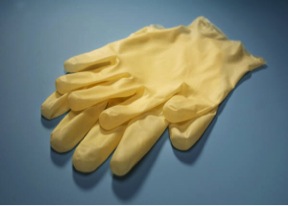 When it comes to hand hygiene, there is an unfortunately all-too-common misconception that wearing gloves makes hand washing or using alcohol-based hand rub unnecessary. In veterinary and human medicine, gloves, like hand hygiene, are typically used for two reasons: to prevent spread of germs or chemicals from a patient/person/object/surface to a person’s hands, and/or to prevent the spread of germs or chemicals from a person’s hands to a patient/person/object/surface. However, gloves are not the infallible barrier to germs that many people would like to think they are. Here are a few reasons why:
When it comes to hand hygiene, there is an unfortunately all-too-common misconception that wearing gloves makes hand washing or using alcohol-based hand rub unnecessary. In veterinary and human medicine, gloves, like hand hygiene, are typically used for two reasons: to prevent spread of germs or chemicals from a patient/person/object/surface to a person’s hands, and/or to prevent the spread of germs or chemicals from a person’s hands to a patient/person/object/surface. However, gloves are not the infallible barrier to germs that many people would like to think they are. Here are a few reasons why:
- Even new gloves can have holes in them: The accepted quality control limit for defects in medical gloves large enough to leak water is 1.5%. That may seem relatively low, but when you consider the hundreds of gloves that may be used over time in a veterinary (or human) clinic, that can add up to a lot of potential hand-to-patient or patient-to-hand pathogen transmission.
- Gloves can be damaged during use: Glove tears or punctures during use can be extremely common, particularly for certain procedures involving anything pointy or sharp (e.g. equipment, teeth, claws) or long procedures. Studies have shown that glove punctures that may occur during surgical procedures are frequently undetected by the person wearing the gloves. Even though gloves may provide an added layer of protection for a time, proper hand hygiene before and after glove use helps reduce the risk of transmission when that barrier breaks down.
- Bacteria can multiply under gloves: Anyone who has ever had to wear any kind of rubber, latex or vinyl gloves for more than 5-10 minutes knows how sweaty and hot it can make your hands, so you can imagine the kind of sweaty soup that can accumulate when gloves need to be worn for even longer than this. That’s why hand hygiene before putting on gloves is so important for “clean” procedures like surgery, because it helps decrease the number of bacteria on the hands to start, and ultimately the amount that will grow back by the time the procedure is done. Hand hygiene after glove removal is important so the “soup” isn’t being spread to the next patient, person or object.
- We use gloves for the highest-risk procedures: Glove use is typically recommended for the cleanest procedures (i.e. surgery) and the dirtiest procedures (i.e. things with a high “ick” factor, like handling feces). A glove puncture in surgery could potentially lead to contamination of sterile tissues, resulting in a surgical site infection. A glove puncture (or contamination of the hands when removing gloves) when handling high-risk material like feces can lead to transmission of fecal pathogens to anyone or anything that person may touch afterward (including themselves). In a sense, hand hygiene is actually even more important in situations when gloves are typically worn!
Although proper glove use and hand hygiene applies primarily to veterinary and healthcare workers, there are times when glove use is also recommended at home (e.g. caring for pets with certain kinds of infections, higher-risk individuals performing certain tasks like cleaning up pet messes). Remember that gloves are not a substitute for hand hygiene – always wash your hands or use hand rub after taking gloves off. It is also important not to touch anything with your gloved hands that will later be touched by someone without gloves, and be sure to put used disposable gloves directly in the garbage.